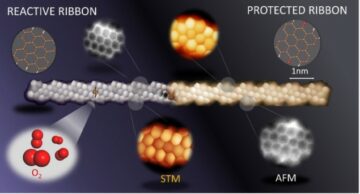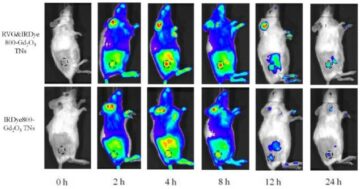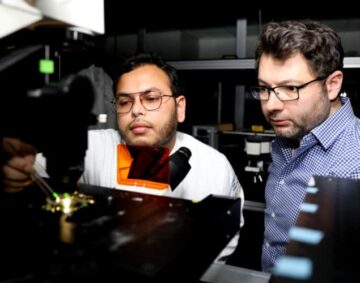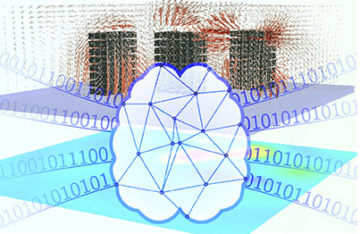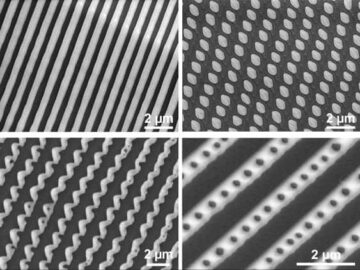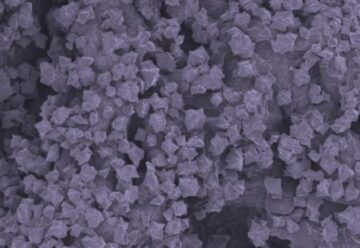
In 1861 James Clerk Maxwell rewrote our understanding of light when he began publishing a description of it in terms of electric and magnetic fields leapfrogging each other as they propagate through space. The resulting “Maxwell equations” arguably rank among some of the most elegant equations in physics – something that it took me a long time to appreciate as I yawned through electromagnetism undergraduate courses wondering whether the topic could ever get interesting. Nonetheless I went on to spend a further three years crunching through Maxwell equations to calculate electric field enhancements around silver nanoparticles while studying “plasmonics” under the guidance of David Richards, professor of physics and vice-dean at King’s College London. At that point I was forced to concede that electromagnetism had genuinely gotten interesting. So it was with more than a little excitement earlier this week, that I walked past the lecture theatres and rooms where Maxwell had researched and taught at my old stomping ground, King’s College London, on my way to hear Naomi Halas one of the pioneers of the field talk at an event organised by Anatoly Zayats, now chair of experimental physics and head of the Photonics & Nanotechnology Group at King’s College London (and my former PhD examiner).
In her own words Halas was working in plasmonics before it even had a name. Hailing from Rice University in the US, she is the Stanley C Moore Professor in electrical and computer engineering, professor of biomedical engineering, chemistry, physics and astronomy, and director of the Laboratory for Nanophotonics, Nanoengineering, Plasmonics, and Nanophotonics. While she laughs off my epithet of “plasmonics pioneer” as we talk over coffee before the lecture, Zayats is quick to add, “Naomi is not only a pioneer in plasmonics but brought the field to real applications.” Her lecture highlights just how far these applications have now reached.
Halas starts by taking us back to a time that even predates Maxwell, to the person Maxwell appealed to for his reference for an appointment at King’s, Michael Faraday. (Zayats has shown Halas and I this very letter, now on display in the physics department.) In “From Faraday to tomorrow” Halas describes how Faraday studied flasks of liquids containing nanoparticles, dye-less solutions with vibrant hues later explained in the theories of Gustav Mie. The colours arise from collective quantized oscillations of electrons in nanoscale structures in response to light, a behaviour of the so-called electron plasma that eventually acquired the name “plasmons”. On resonance the scattering of light by a plasmonic nanoparticle shapes an incident light field in a way that greatly outsizes the particle itself, and this attribute together with the ability to tune the resonance with nanoparticle size, composition and shape has sparked a wide range of new technologies.
Already in 1951 Arthur Aden and Milton Kerker had proposed the theory that more complex core-shell structures could provide additional “control knobs” for tuning these resonances. But theory is one thing, and when Halas began her career in plasmonics in 1990, nanotechnology was practically synonymous with sci-fi. “Our starting point in the field was working out how to create these particles,” she tells attendees. However as nanosynthesis approaches advanced, ideas for manipulating light with nanoparticles really began to unfurl.
But what can you do with it?
As Halas explains, researchers were quick to see potential in using plasmonic structures to manipulate light for new types of lenses and for sensing chemicals through resonance shifts. However, one of the first characteristics that caught her attention was the potential to excite resonant responses in the near infrared, a wavelength at which people’s bodies are transparent. Halas and her colleagues showed that since light at these wavelengths can pass through human tissues, it can excite a nanoparticle at a cancer tumour so that it heats up and destroys the cancerous cells. This photothermal cancer therapy is now already used in clinics, and thanks to developments in imaging there has been great success in using it to treat prostate cancer.
Halas goes on to explain that the same highly localized electromagnetic field enhancements that can kill a tumour, can be a powerful tool for tackling environmental resource issues as well. A billion people around the world lack access to clean water, but technology based on plasmonic nanoparticles can heat water to purify it without the high energy consumption that makes traditional reverse osmosis purification plants so expensive. Plasmons decay by releasing “hot” electrons that have a lot of energy, which can catalyse chemical reactions to occur at greatly reduced temperatures and pressures – again saving energy. Production of ammonia alone – a staple chemical widely used in agriculture – is responsible for 5% of the world’s energy consumption, so these nanoparticles have potential to make a huge difference. Halas also suggests that photoassisted catalysis could provide solutions to hydrogen production at sufficiently affordable costs for a more environmentally friendly hydrogen energy economy to finally take off. And developments to exploit plasmon resonances in “commoner” metals like aluminium – as opposed to the gold and silver predominantly used so far – could make these technologies more sustainable still.

Plasmonic nanoparticles boost light emission
It’s easy to see what is attractive about plasmonics research now, but what was it that first motivated researchers to pursue the field when all there was to go on was Faraday’s flasks of attractively coloured liquids? Zayats, whose research over the years has also shaped the field, points to the unique properties of plasmonic systems, their very strong field confinement and light concentration. “Then you start thinking ‘where can I apply this where can it be an advantage?’ – and this drives the research forward.”
Plasmonics developments now lie very much at the interface of several disciplines from quantum chemistry for precision production of nanoparticles with the right properties, physics to understand their behaviour, biology, medicine, electronics and catalysis to understand what this might mean for a particular application, and of course reams of regulatory and business knowhow if any of these technologies are to get to the market place. “It is inherently very multidisciplinary,” says Halas. “In every field you have the challenge of getting people from very different backgrounds, educations and orientations to learn to work together – I think that is the big science challenge, a big science human challenge.”
- SEO Powered Content & PR Distribution. Get Amplified Today.
- PlatoData.Network Vertical Generative Ai. Empower Yourself. Access Here.
- PlatoAiStream. Web3 Intelligence. Knowledge Amplified. Access Here.
- PlatoESG. Automotive / EVs, Carbon, CleanTech, Energy, Environment, Solar, Waste Management. Access Here.
- PlatoHealth. Biotech and Clinical Trials Intelligence. Access Here.
- ChartPrime. Elevate your Trading Game with ChartPrime. Access Here.
- BlockOffsets. Modernizing Environmental Offset Ownership. Access Here.
- Source: https://physicsworld.com/a/plasmonics-technologies-take-on-global-challenges/
- :has
- :is
- :not
- :where
- $UP
- 160
- 1951
- 90
- a
- ability
- About
- AC
- access
- acquired
- add
- Additional
- advanced
- ADvantage
- affordable
- again
- agriculture
- All
- alone
- already
- also
- Ammonia
- among
- an
- and
- any
- Application
- applications
- Apply
- appointment
- appreciate
- approaches
- ARE
- arguably
- arise
- around
- AS
- astronomy
- At
- attendees
- attention
- attractive
- back
- backgrounds
- based
- BE
- been
- before
- began
- Big
- Billion
- biology
- biomedical
- bodies
- boost
- brought
- business
- but
- by
- calculate
- CAN
- Cancer
- Career
- catalyse
- caught
- Cells
- Chair
- challenge
- challenges
- characteristics
- chemical
- chemicals
- chemistry
- click
- Coffee
- colleagues
- Collective
- College
- complex
- composition
- computer
- Computer Engineering
- concentration
- consumption
- Costs
- could
- course
- courses
- create
- credit
- Department
- description
- developments
- difference
- different
- Director
- disciplines
- Display
- do
- drives
- each
- Earlier
- easy
- economy
- Electric
- Electronics
- electrons
- energy
- Energy Consumption
- Engineering
- enhancements
- environmental
- environmentally
- environmentally friendly
- equations
- Ether (ETH)
- Even
- Event
- eventually
- EVER
- Every
- examiner
- Excitement
- expensive
- experimental
- Explain
- explained
- Explains
- Exploit
- far
- field
- Fields
- Finally
- First
- For
- forced
- Former
- Forward
- friendly
- from
- further
- get
- getting
- Global
- Go
- Goes
- Gold
- great
- greatly
- Ground
- Group
- guidance
- had
- Have
- he
- head
- hear
- her
- High
- highlights
- highly
- his
- How
- How To
- However
- http
- HTTPS
- huge
- human
- hydrogen
- i
- ideas
- if
- image
- Imaging
- in
- incident
- information
- inherently
- interesting
- Interface
- issue
- issues
- IT
- itself
- james
- jpg
- just
- Kill
- laboratory
- Lack
- later
- LEARN
- Lecture
- lenses
- letter
- lie
- light
- like
- little
- London
- Long
- long time
- Lot
- make
- MAKES
- manipulating
- Market
- max-width
- Maxwell
- me
- mean
- medicine
- Metals
- Michael
- might
- Milton
- more
- most
- motivated
- much
- multidisciplinary
- my
- name
- Nanophotonics
- nanotechnology
- Near
- New
- New technologies
- now
- occur
- of
- off
- Old
- on
- ONE
- only
- open
- opposed
- Osmosis
- Other
- our
- out
- over
- own
- particle
- particular
- pass
- past
- People
- people’s
- person
- phd
- Physics
- Physics World
- pioneer
- pioneers
- Place
- plants
- Plasma
- plato
- Plato Data Intelligence
- PlatoData
- Point
- points
- potential
- powerful
- practically
- Precision
- predominantly
- pressures
- Production
- Professor
- properties
- proposed
- provide
- Publishing
- Quantum
- Quick
- range
- rank
- reached
- reactions
- real
- really
- Reduced
- reference
- regulatory
- releasing
- research
- researchers
- resonance
- resource
- response
- responses
- responsible
- resulting
- reverse
- Rice
- right
- Rooms
- same
- saving
- says
- sci-fi
- Science
- see
- several
- Shape
- shaped
- shapes
- she
- Shifts
- showed
- shown
- Silver
- since
- Size
- So
- so Far
- Solutions
- some
- something
- Space
- sparked
- spend
- stanley
- start
- Starting
- starts
- Still
- strong
- studied
- Studying
- success
- Suggests
- sustainable
- synonymous
- Systems
- tackling
- Take
- taking
- Talk
- taught
- Technologies
- Technology
- tells
- terms
- than
- thanks
- that
- The
- the world
- their
- theory
- therapy
- There.
- These
- they
- thing
- Think
- Thinking
- this
- this week
- three
- Through
- thumbnail
- time
- tissues
- to
- together
- took
- tool
- topic
- traditional
- transparent
- treat
- true
- types
- under
- understand
- understanding
- unique
- university
- us
- used
- using
- very
- vibrant
- walked
- was
- Water
- wavelengths
- Way..
- we
- week
- WELL
- went
- were
- What
- What is
- when
- whether
- which
- while
- whose
- wide
- Wide range
- widely
- with
- without
- wondering
- words
- Work
- work together
- working
- working out
- world
- world’s
- years
- you
- zephyrnet




